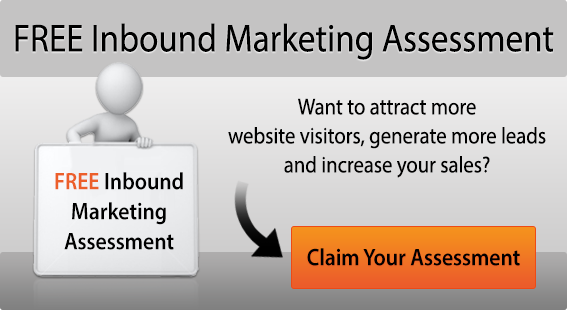Expert Opinion: How To Get Started With Inbound Marketing For Your Small Business
by Andy Gibbins on 26-Dec-2022 11:30:00

If you haven’t got the systems, tools, and strategy already in place, it isn’t always clear how to get started with inbound marketing as a small business. At the start of the journey, it can feel like there are a lot of new skills to learn, and a lot of money to spend, before you start seeing results – and it doesn’t help that the Internet is full of conflicting advice about the best way of investing your money for the best returns.
In this article, we explain the first 5 steps a business owner should take when embarking on inbound marketing.
Step 1: The basics: setting up the infrastructure for inbound marketing
To manage an inbound marketing strategy, you will need knowledge and a team – whether in-house or through working with an established inbound marketing agency like JDR.
The HubSpot Academy is a good place to start for basic information, which you can add to over time. HubSpot offer a free, video-based introductory Inbound Marketing Course that you can complete in just a few hours. Although it is designed for entry-level inbound professionals and marketers, it also has a lot of content to offer for business owners, too.
In terms of people, you’ll need a team of at least five skilled, experienced marketing professionals:
- Marketing Executive
- Content writer
- Graphic designer
- Web developer/designer
- Marketing Coordinator
While some larger businesses employ in-house marketing teams, for most SMEs the most cost-effective strategy is to work with an agency that already has the people and resources in place to hit the ground running delivering your marketing campaign.
Step 2: Evaluate your current marketing assets
Unless you are a start-up business, you may already have marketing assets and activities in place that you could retain as part of your new inbound strategy. Take an internal audit of the following:
- Digital assets – your website, leads database, content (web content, blog articles, guides etc), social media accounts, images, videos, brand materials etc
- Software – CRM, marketing automation platform etc
- Current activities – SEO, blogging, social media activity, email marketing, PPC etc
- Marketing budget – what can you afford to spend on inbound?
Step 3: Establish marketing goals based on your business goals
Marketing is a means to an end to serve your business goals, so you’ll need to establish a series of strategic marketing goals that align with your business objectives.
We recommend starting with how much revenue you want to generate through inbound marketing. From this, you can calculate how many sales you’ll need to achieve this target, and the number of sales-qualified leads (SQLs) to secure each sale.
Continue this progression by identifying the number of marketing qualified leads (MQLs) needed to reach your SQL target, the number of overall website leads, and finally, the volume of website visitors needed to start the entire process.
To be measurable, your marketing goals should be time-based, with annual, quarterly, or monthly milestones. So, an initial marketing goal could be to secure an additional 10,000 website visitors within the first 12 months.
Your marketing goals will form the basis of your strategy, with all activities geared towards securing success with each KPI – ultimately letting you hit your revenue targets.
Step 4: Create Buyer Personas/Ideal Customer profiles
Inbound marketing hinges on creating online content for very specific audiences – these are your buyer personas, or ideal customer, profiles. Creating a buyer persona document lets you analyse the type of people your business sells to (note that for B2B businesses, your buyer personas aren’t other companies, they are people working within these companies).
Write a buyer persona document for each of your main buyer types, with each one being a fictitious but representative profile of a real person. Details to think about include:
- Job title and role/responsibilities.
- Who do they report to in their company – i.e. can they make sales decisions on their own authority?
- Demographic information (gender, age bracket etc).
- Level of education and experience.
- Communication style.
- Professional background and memberships.
- Pain points and problems encountered in their role.
- How they research solutions to these issues – social media, company blogs, trade shows, Google, industry journals etc.
- How they make sales decisions and the processes involved.
Step 5: Formulate a marketing strategy
With the foundations in place, you will be in a strong position to develop a marketing strategy that meets your business objectives and aligns with the needs and purchase motivations of your target customers.
There are several ways to develop a marketing strategy and a variety of activities and channels are available to help you expand your business profile online and attract your ideal customers. There are also various tools and software platforms you may find useful to optimise your budget and time resources.
At JDR, we use a proven sales and marketing system as a framework that you can adapt to your budget, your business model, and the requirements of your customers.
Every marketing strategy involves creating content to drive traffic to your website and encourage conversions, and measuring your results, making targeted improvements wherever necessary.
At its core is a cautious process of risk management and mitigation – backed up by painstaking data collection and analysis – to ensure that no cash is wasted and that investments and resources are channelled into the most appropriate and cost-effective sales channels.
To find out more about your next steps
Implementing a personalised marketing game plan and strategy that delivers on your revenue goals, please call one of our inbound team today on 01332 982197.
Image Source: Pexels
- Inbound Marketing (SEO, PPC, Social Media, Video) (827)
- Strategy (366)
- Sales & CRM (195)
- Marketing Automation & Email Marketing (190)
- Business Growth (165)
- Website Design (160)
- Hubspot (138)
- Lead Generation (116)
- Google Adwords (99)
- Content Marketing (94)
- Conversion (51)
- Case Studies (47)
- News (47)
- Ecommerce (39)
- Webinars (34)
- SEO (25)
- AI (20)
- Events (19)
- LinkedIn Advertising (17)
- Video (17)
- Video Selling (15)
- Software training (13)
- Niche business marketing (11)
- The Digital Prosperity Podcast (10)
- Facebook Advertising (6)
- HubSpot Case Studies (5)
- January 2026 (1)
- December 2025 (15)
- November 2025 (6)
- October 2025 (17)
- September 2025 (16)
- August 2025 (14)
- July 2025 (14)
- June 2025 (5)
- May 2025 (19)
- April 2025 (15)
- March 2025 (13)
- February 2025 (13)
- January 2025 (8)
- December 2024 (2)
- November 2024 (4)
- October 2024 (21)
- September 2024 (4)
- August 2024 (8)
- July 2024 (14)
- June 2024 (16)
- May 2024 (25)
- April 2024 (15)
- March 2024 (18)
- February 2024 (5)
- January 2024 (10)
- December 2023 (6)
- November 2023 (10)
- October 2023 (13)
- September 2023 (12)
- August 2023 (14)
- July 2023 (13)
- June 2023 (14)
- May 2023 (15)
- April 2023 (13)
- March 2023 (14)
- February 2023 (13)
- January 2023 (15)
- December 2022 (13)
- November 2022 (6)
- October 2022 (8)
- September 2022 (22)
- August 2022 (15)
- July 2022 (13)
- June 2022 (16)
- May 2022 (14)
- April 2022 (16)
- March 2022 (17)
- February 2022 (11)
- January 2022 (8)
- December 2021 (6)
- November 2021 (7)
- October 2021 (11)
- September 2021 (10)
- August 2021 (7)
- July 2021 (7)
- June 2021 (4)
- May 2021 (4)
- April 2021 (1)
- March 2021 (3)
- February 2021 (5)
- January 2021 (4)
- December 2020 (7)
- November 2020 (6)
- October 2020 (5)
- September 2020 (9)
- August 2020 (18)
- July 2020 (17)
- June 2020 (17)
- May 2020 (10)
- April 2020 (21)
- March 2020 (24)
- February 2020 (21)
- January 2020 (12)
- December 2019 (23)
- November 2019 (12)
- October 2019 (14)
- September 2019 (16)
- August 2019 (15)
- July 2019 (13)
- June 2019 (6)
- May 2019 (8)
- April 2019 (4)
- March 2019 (2)
- February 2019 (2)
- January 2019 (2)
- December 2018 (3)
- November 2018 (24)
- September 2018 (11)
- August 2018 (9)
- June 2018 (3)
- May 2018 (6)
- April 2018 (14)
- March 2018 (12)
- February 2018 (16)
- January 2018 (15)
- December 2017 (15)
- November 2017 (18)
- October 2017 (23)
- September 2017 (19)
- August 2017 (28)
- July 2017 (27)
- June 2017 (25)
- May 2017 (18)
- April 2017 (17)
- March 2017 (16)
- February 2017 (17)
- January 2017 (14)
- December 2016 (21)
- November 2016 (27)
- October 2016 (25)
- September 2016 (16)
- August 2016 (20)
- July 2016 (19)
- June 2016 (14)
- May 2016 (20)
- April 2016 (24)
- March 2016 (22)
- February 2016 (28)
- January 2016 (27)
- December 2015 (28)
- November 2015 (19)
- October 2015 (9)
- September 2015 (12)
- August 2015 (5)
- July 2015 (1)
- June 2015 (10)
- May 2015 (3)
- April 2015 (11)
- March 2015 (14)
- February 2015 (15)
- January 2015 (12)
- December 2014 (2)
- November 2014 (23)
- October 2014 (2)
- September 2014 (2)
- August 2014 (2)
- July 2014 (2)
- June 2014 (7)
- May 2014 (14)
- April 2014 (14)
- March 2014 (7)
- February 2014 (2)
- January 2014 (7)
- December 2013 (9)
- November 2013 (14)
- October 2013 (17)
- September 2013 (3)
- August 2013 (6)
- July 2013 (8)
- June 2013 (4)
- May 2013 (3)
- April 2013 (6)
- March 2013 (6)
- February 2013 (7)
- January 2013 (5)
- December 2012 (3)
- November 2012 (2)
- September 2012 (1)
Subscribe by email
You May Also Like
These Related Blogs

Inbound Marketing Is The Future of Business
How The ‘State Of Inbound Marketing Report’ Proves That You Need To Implement Inbound Marketing Now! As new procedures, advancements in digital market …

Why Inbound Marketing Is The Future Of B2B Marketing
We’ll start by saying that inbound marketing is the present of B2B marketing, as well as the future. B2B purchasing behaviour today is very different …

Inbound Marketing - Which Premiership Football Team Are YOU?
I have two big passions in life. At work my passion is for Inbound Marketing; helping businesses discover the benefits of Inbound Marketing and seeing …




